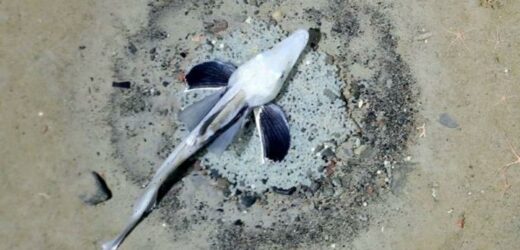Antarctica: Scientists find area where no life exists
We use your sign-up to provide content in ways you’ve consented to and to improve our understanding of you. This may include adverts from us and 3rd parties based on our understanding. You can unsubscribe at any time. More info
The breeding colony of fish spanned at least 150 square miles and included about 60 million active icefish nests. Finding a colony this large has been unprecedented, representing a biomass of more than 60,000 tons – or over 135 million lbs. Each of the nests was occupied by a single adult icefish, that would guard more than 1,700 eggs.
The researchers noted there were many fish carcasses found within and near the site, suggesting that the notothenioids, or icefish, play an important role in the wider food web.
These creatures were particularly under threat from seals and other predators.
Dr Autun Purser, lead author of the findings, reported in journal Current Biology, said: “A great many seals spend much of their time in close proximity to the fish nests.
“We know this from historical tracking data and fresh tracking data from our cruise. The nests are exactly where the warmer water is upwelling.


“These facts may be coincidence, and more work is needed, but the recorded seal data show seals do indeed dive to the depths of the fish nests, so may well be dining on these fish.”
The mysterious icefish colony is located in the southern Weddell Sea on the eastern side of the Peninsula.
Their bodily fluids contain antifreeze proteins that enable them to survive the very cold temperatures of the Southern Ocean.
As a result, blood is less thick and sticky – increasing supply of oxygen to organs.

Dr Purser, of the Alfred Wegener Institute, Bremerhaven, said: “Our most important finding is the pure existence of such an extensive icefish brooding colony.
“A few dozen nests have been observed elsewhere in the Antarctic – but this find is orders of magnitude larger.”
Dr Purser said: “We did not know to expect any sort of fish nest ecosystem.”
That part, he adds, came as a “total surprise.”
Dr Purser said: “After the spectacular discovery of the many fish nests, we thought about a strategy on board to find out how large the breeding area was – there was literally no end in sight.”
DON’T MISS:
Covid breakthrough: Face mask effectiveness exposed in study [REVEAL]
Arthritis breakthrough as groundbreaking tech could spark recovery. [INSIGHT]
Boris takes another blow as Jonathan Van-Tam leaves role [SPOTLIGHT]


Some nests were “active”, with between 1,500 and 2,500 eggs and guarded in three-quarters of cases by an adult icefish of the species Neopagetopsis ionah.
Others contained only eggs. There were also unused nests, in the vicinity of which either only a fish without eggs could be seen, or a dead fish.
They were a popular destination for seals in search of food. Transmitters attached to the marine mammals showed 90 percent of diving activities occurred there.
It’s likely to be the most spatially extensive contiguous fish breeding colony discovered worldwide to date.
Bettina Stark-Watzinger, German Federal Research Minister, said: “My congratulations to the researchers involved on their fascinating discovery.
“This discovery can make an important contribution towards protecting the Antarctic environment.”
Source: Read Full Article


